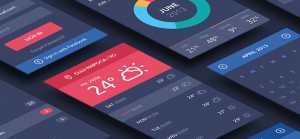Making App Design Beautiful And Useful
— June 18, 2015The Importance of User Interface Design
In finance, professionals encounter user interfaces daily—whether on desktops, tablets, or phones. These interfaces, often overlooked unless poorly designed, are essential tools for managing complex workflows. Crafting effective interfaces demands a rare combination of data expertise, technical proficiency, and an intuitive sense of design.
Mike Lee, a principal in user experience design at Eikos Partners, emphasizes that excellent design begins with an artistic sensibility. He evaluates designers based on their mastery of layout, spacing, color, size, and overall style. According to Lee, the arrangement of elements on the screen must prioritize user convenience. On desktop interfaces, for instance, corners hold significant value due to their accessibility via quick mouse movements. For mobile application development, actionable items should reside at the bottom of the screen, where they can be reached with one hand.
Moreover, visual clutter undermines functionality. Lee stresses the importance of negative space, citing studies that demonstrate how increased margins between paragraphs enhance comprehension. While traders may prefer crowded displays to view more data, this approach often leads to confusion.
Contemporary design trends favor a flat aesthetic, as seen in platforms like Windows 10. Unlike older interfaces laden with textures and chrome effects, flat designs provide a cleaner, less distracting experience. While critics sometimes dismiss the flat style as overly simplistic, its clarity and usability often outweigh aesthetic objections.
The Blend of Art and Technology
Lee’s passion for design began in his youth, rooted in his love for art and drawing. This interest evolved during high school when he discovered web application development design—a field that merges creative expression with technical problem-solving. Opting to study computer science at Stevens Institute of Technology, Lee gained a deep understanding of both data and technology, equipping him with the skills to excel in modern user interface design.
The demand for this dual expertise is evident in job postings under “Data Visualization” on LinkedIn. These roles often prioritize computer science backgrounds over graphic arts, with a focus on proficiency in tools like Tableau, QlikView, Omniscope, and MicroStrategy. Knowledge of programming languages such as Java, D3, R, SAS, and Python further enhances a candidate’s appeal.
Data Visualization and Its Tools
Data visualization plays a pivotal role in bridging the gap between complex datasets and actionable insights. Historically, graphic departments were responsible for transforming raw data into comprehensible visuals. However, the rise of interactive media has shifted this responsibility to professionals skilled in creating dynamic data views.
Tableau stands out as a leading tool in this field. Its user-friendly interface allows individuals to craft visually appealing presentations with minimal effort. Tableau’s free version has made it a popular choice among professionals. For example, bankers in London’s Canary Wharf often invest their own money to acquire Tableau licenses, recognizing its ability to elevate their presentations’ quality.
Tableau’s functionality relies on a drag-and-drop system, enabling users to explore data intuitively. The platform’s built-in capabilities support the creation of visuals that are both aesthetically pleasing and easy to interpret. While some advanced solutions require programming knowledge, Tableau eliminates this barrier, making data visualization accessible to a broader audience.
The Role of Programming in Visualization
Despite the rise of user-friendly tools, programming remains an essential skill for advanced visualization projects. Technologies like D3.js, commonly used for interactive data visualizations, rely on JavaScript. Professionals with a background in computer science or programming can leverage these tools to create bespoke visual experiences.
Institutions like the University of Washington have recognized this need, offering courses in Human-Centered Design and Engineering. These programs introduce students to visualization without requiring extensive programming experience. As tools evolve, the emphasis shifts toward analytical thinking and creative problem-solving rather than technical proficiency alone.
Bridging Design and Technology in Global Markets
Internationally, Vietnam software outsourcing companies like S3Corp. are investing in enhancing their design capabilities. By combining strong technical foundations with innovative design practices, these firms aim to meet the growing demand for effective app interfaces.
As the boundaries between design and technology blur, professionals must adapt to new tools and methodologies. Analytical thinking, supported by intuitive platforms, empowers users to extract insights from data without relying solely on programming expertise.
The Future of App Design
The future of app design represents a pivotal shift driven by technological innovation, creative expression, and human-centric strategies. As businesses and users continue to demand applications that deliver efficiency and delight, understanding emerging trends is essential. App design today is not just a technical endeavor; it is an intricate blend of user psychology, technological capability, and aesthetic simplicity. This exploration provides a deep dive into the defining trends that are shaping the future of web and mobile applications, emphasizing detail and clarity.
By embracing new technologies and fostering interdisciplinary expertise, designers can create solutions that resonate with users across industries.
AI-Powered Personalization
Artificial intelligence (AI) is revolutionizing app design by enabling personalization at an unprecedented scale. Adaptive interfaces represent a leap forward, allowing applications to modify layouts, settings, and functionalities based on individual user behaviors. For instance, apps can now analyze usage patterns, such as frequently accessed features or navigation habits, to create an environment tailored to the user’s unique preferences.
Intelligent recommendations further enhance the user experience by offering content, products, or actions that align with past interactions. These recommendations are not static but evolve as the app gathers more data, ensuring the user is presented with timely and relevant suggestions. Such features are particularly significant in sectors like e-commerce, media, and health, where tailored solutions can significantly enhance engagement and retention. Leveraging AI-driven insights can differentiate their offerings in web and mobile solutions.
Voice and Gesture Interfaces
The rise of voice and gesture interfaces has redefined how users interact with digital platforms. Voice assistants, integrated into apps, allow users to perform tasks without physical input. From scheduling appointments to querying information, these assistants make apps more accessible, especially for individuals with mobility or dexterity challenges.
Gesture recognition, on the other hand, offers intuitive control mechanisms that align with natural human movements. Users can navigate, zoom, or manipulate objects within an app using simple hand motions. This advancement holds particular promise for applications in AR and VR environments, where conventional input methods might be cumbersome or impractical. Incorporating these features into app design requires a focus on precision and responsiveness, ensuring seamless functionality.
Augmented Reality (AR) and Virtual Reality (VR)
Augmented Reality (AR) and Virtual Reality (VR) are no longer niche technologies; they are central to creating immersive experiences that bridge the digital and physical worlds. AR overlays virtual objects onto real-world environments, enabling applications like virtual try-ons for retail, enhanced educational tools, or navigation aids. Virtual Reality takes immersion further by transporting users into fully digital environments, offering opportunities for gaming, training simulations, and collaborative workspaces.
A notable innovation within these domains is spatial computing, which uses 3D user interfaces that interact with the physical space surrounding the user. This creates an interactive and dynamic experience where users can manipulate objects or data within a simulated environment. For companies involved in web and mobile app development outsourcing, particularly in tech hubs like Vietnam, incorporating AR and VR capabilities into projects can significantly enhance client value propositions.
Dark Mode and Minimalism
The adoption of dark mode across apps has transitioned from a trend to an expectation. By reducing the strain on users’ eyes in low-light settings, dark themes improve readability and overall usability. This feature has become especially relevant as users spend longer periods interacting with screens, whether for work or leisure.
Minimalistic design complements dark mode by emphasizing clean, uncluttered interfaces. By prioritizing essential content and eliminating distractions, minimalist designs create an intuitive and visually appealing experience. The challenge lies in striking a balance—ensuring simplicity does not compromise functionality or accessibility. For example, in e-commerce apps, minimalism can streamline navigation while highlighting key products or promotions.
Ethical Design and Accessibility
Ethical app design has gained momentum as businesses recognize the importance of inclusivity and user trust. Accessible design ensures that apps can be used by individuals with diverse abilities, from those with visual impairments to users relying on screen readers. Features like adjustable font sizes, color contrast settings, and voice-assisted navigation exemplify inclusivity in action.
Privacy-focused design also plays a critical role in building trust. Users are increasingly aware of data privacy concerns, making transparent policies and secure data handling practices essential. App developers must implement encryption, permission-based data collection, and clear communication about how user data is used.
Interdisciplinary Collaboration in App Design
Innovative app design is rarely the work of a single discipline. Collaboration between designers, developers, UX researchers, and AI experts is essential for creating applications that resonate with users. Designers and developers must work together to ensure that creative visions translate into seamless technical implementation. By understanding constraints and possibilities on both ends, they can bridge the gap between form and function.
UX researchers and psychologists contribute by studying user behaviors, preferences, and emotional responses. Their insights inform design decisions, ensuring apps meet the actual needs of their target audiences. Meanwhile, AI and machine learning specialists enable the integration of predictive features, enhancing automation and personalization. For businesses specializing in outsourced development, fostering such multidisciplinary teamwork can drive innovation and quality in deliverables.
A Comprehensive Approach to App Design
Creating impactful apps requires a multifaceted approach that addresses user needs, technical challenges, and market trends. User-centered design is at the core of this process, emphasizing empathy and user involvement. By conducting interviews, usability tests, and iterative design reviews, developers can ensure the final product aligns with user expectations.
Intuitive navigation is another critical element, as users should be able to achieve their goals with minimal effort. Clear menus, logical workflows, and responsive touchpoints contribute to a fluid experience. Performance optimization further enhances user satisfaction by minimizing load times, crashes, or lag. Apps must function consistently across devices and screen sizes, ensuring accessibility regardless of the user’s hardware.
Continuous testing and iteration are vital for maintaining app quality and relevance. By collecting user feedback and analyzing performance metrics, developers can identify pain points and opportunities for improvement. This ongoing process ensures that apps evolve alongside user needs and technological advancements.
Conclusion
App design is about creating intuitive, functional, and engaging user experiences. The future of app design is driven by AI, voice, gesture, and AR/VR technologies. These technologies enable personalized, hands-free, and immersive experiences.
However, accessibility and ethics are crucial. App design should be inclusive, and ethical design protects user privacy.
Effective app design requires collaboration between designers, developers, UX researchers, and AI specialists.
An app’s success depends on its ability to meet user needs. By focusing on value, user experience, and adaptability, developers can create lasting and impactful apps. Staying updated with the latest trends is essential for innovation and success.






